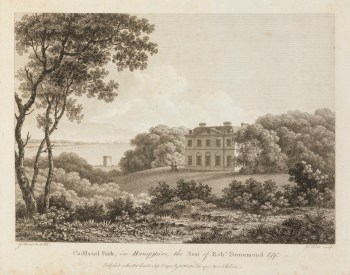George Barret RA
RA Collection: People and Organisations
George Barret was a Founder Member of the Royal Academy, and was celebrated for his idealised paintings of British and Irish landscapes.
Born in Dublin, the son of a tailor, Barret was apprenticed to a corset-maker before working on hand-colouring prints for the print seller Thomas Silcock. He also attended classes run by the painter Robert West in Dublin. He befriended the statesman Edmund Burke while Burke was a student at Trinity College Dublin. It is thought that Barret’s early landscapes were influenced by the ideas set forth in his friend’s 1757 publication, A Philosophical Enquiry into the Origin of Our Ideas of the Sublime and Beautiful. In that same year Barret married Frances Percy and together they had three sons and a daughter, all of whom became painters.
One of Barret’s early patrons was the Irish nobleman Lord Powerscourt, for whom Barret completed several paintings of his estate, including View of Powerscourt Waterfall. However, he was unable to persuade Powerscourt to fund engravings of his work, which would have enabled Barret to profit from further sales. This disappointment may have prompted his move to London in the 1763.
By this time, Barret had developed an independent and recognisable style. In London, he attracted several wealthy patrons and worked prolifically. His specialisation of landscape paintings made him popular among landowners who wanted to see their estates captured on canvas, making him one of the highest-earning artists of the time. Some of his paintings have been described as formulaic relying on the same stock images and motifs – a criticism that may be explained by the sheer volume of paintings he produced each year.
As a Founder Member, Barret exhibited thirty-one pictures at the Royal Academy between 1769 and 1781, many of romantic and mountainous landscapes. He frequently collaborated with his fellow Royal Academicians; for example, he painted the “landscape” of Sawrey Gilpin’s Broodmares and Colts in a Landscape.
Despite his professional success, Barret struggled financially, possibly due to poor handling of his business affairs. A patron, William Lock the Elder, apparently commissioned Barret to paint a mural in 1780 in order to save him from bankruptcy. In 1782 Burke helped to ensure Barret’s appointment as master painter for the Chelsea Hospital. Although the post came with a substantial salary, when Barret died in 1784 he left his wife and children bankrupt. He was buried in Paddington.
Profile
Foundation Member
Died: 29 May 1784
Nationality: Irish
Elected RA: 10 December 1768
Gender: Male
Preferred media: Painting
Works by George Barret in the RA Collection
3 results
Works after George Barret in the RA Collection
5 results
-
![George Barret RA, The Seats of the Nobility and Gentry,]()
After George Barret RA
Cadland Park, in Hampshire, the seat of R. Drummond Esq., 1 September 1780
Etching with engraving
-
![George Barret RA, The Seats of the Nobility and Gentry,]()
After George Barret RA
Kedleston House in Derbyshire, the seat of Lord Scarsdale, 2 September 1780
Etching with engraving
-
![George Barret RA, The Seats of the Nobility and Gentry,]()
After George Barret RA
The Lodge, in Richmond Park, the residence of Philip Medows Esq., 1 January 1780
Etching with engraving
-
![George Barret RA, The Seats of the Nobility and Gentry,]()
After George Barret RA
Burton Constable, in Yorkshire, the seat of W. Cavendish Esq., 1 August 1779
Etching with engraving
-
![George Barret RA, The Seats of the Nobility and Gentry,]()
After George Barret RA
Claremont in Surry, the seat of Lord Clive, 1 April 1779
Etching with engraving
Associated books
2 results
-
John Hamilton F.R.S.
Stereography, Or, A Compleat Body Of Perspective, In all its Branches. Teaching to describe, by Mathematical Rules, The Appearances of Lines, Plain Figures, and Solid Bodies, Rectilinear, Curvilinear, and Mixed, in all manner of Positions. Together with their Projections or Shadows, And Their Reflections by Polished Planes. The Whole performed by Uniform, Easy, and General Methods, For the most Part entirely New. In Seven Books. By J. Hamilton, Esq; F.R.S. In Two Volumes. Vol. I. - London,: [1738]
03/2825
-
William Watts
The Seats of the Nobility and Gentry, in a Collection of the most interesting & Picturesque views, Engraved by W. Watts From Drawings by the most eminent Artists. With descriptions of each View. - London: January 1st 1779 [- May 20th 1786]
06/326
Associated archives
7 results
-
James Northcote, to Samuel Northcote, Plymouth
[29 Mar 1772]
Item NOR/8
-
R. Smirke, Upper Fitzroy Street, to Sir Thos. Lawrence
18 May 1822
Item LAW/4/24
-
George Barret, Orchard Street, to the President
25 Feb 1768
Item SA/36/42
-
George Barret, Orchard Street, to the President
25 Nov 1768
piece SA/18/7







